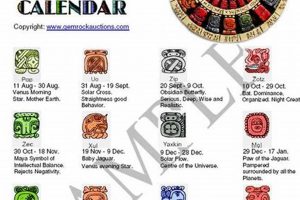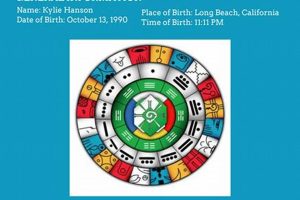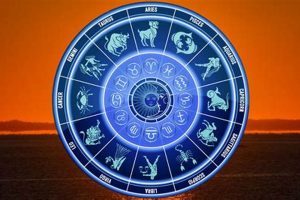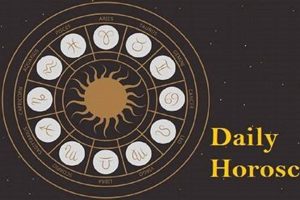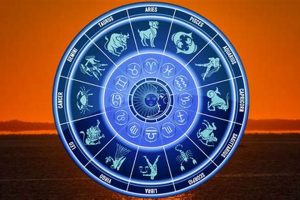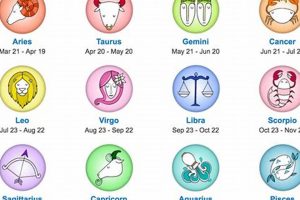In the Mayan calendar system, each day is associated with a specific glyph representing a combination of solar and sacred energies. These glyphs, analogous to Western zodiac signs, influence an individual’s perceived characteristics, strengths, weaknesses, and destiny based on their birth date. For instance, someone born under the sign of Imix might be associated with primal energy and creation.
Understanding these daily influences provided a framework for ancient Mayans to make decisions, schedule ceremonies, and navigate their lives in harmony with the cosmos. This practice reflected a deep connection to the natural world and the cyclical nature of time, influencing their agriculture, social structures, and even architecture. This system differs from Western astrology, which primarily focuses on the position of celestial bodies at the time of birth.
This understanding of the Mayan calendrical system and its related divination practices provides a rich context for exploring Mayan culture, beliefs, and worldview. Further exploration of specific glyphs, their associated meanings, and their role in Mayan society will illuminate the significance of this intricate system.
Tips for Understanding Mayan Astrology
Gaining insight into the Mayan calendar system provides a unique perspective on personality traits and life paths. The following tips offer guidance for exploring this ancient system.
Tip 1: Determine Birth Glyph: Accurate interpretation relies on identifying the specific glyph associated with one’s birth date. Several online resources and printed materials offer conversion tools and detailed descriptions of each glyph.
Tip 2: Research Glyph Attributes: Each glyph possesses unique characteristics and symbolic meanings. Explore these attributes to understand potential strengths, weaknesses, and life themes.
Tip 3: Consider the Mayan Calendar’s Cyclical Nature: The Mayan calendar is based on interconnected cycles. Understanding these cycles, such as the Tzolkin and Haab, adds depth to interpretations.
Tip 4: Consult with Experts: For in-depth understanding, consider consulting with scholars or practitioners specializing in Mayan astrology and calendrics. They can offer personalized insights and guidance.
Tip 5: Avoid Generalizations: While glyph descriptions provide valuable insights, avoid rigid interpretations. Individual experiences and free will play crucial roles in shaping one’s life path.
Tip 6: Study Mayan Culture and History: Exploring Mayan history, cosmology, and beliefs provides a broader context for understanding the significance of the calendar system and its associated astrological interpretations.
By following these tips, individuals can cultivate a deeper appreciation for the Mayan calendar and its potential to offer self-awareness and guidance. These insights can contribute to a more meaningful understanding of one’s place within the larger cosmos.
Further investigation of the Mayan calendar system offers a captivating journey into an ancient worldview. This exploration encourages reflection on the interconnectedness of time, destiny, and individual potential.
1. Daily Glyphs
Daily glyphs form the foundation of Mayan astrology. Each day within the 260-day Tzolkin calendar corresponds to a unique glyph, representing specific energies and influences. These glyphs are not merely symbolic; they are considered active forces shaping the characteristics and destinies of individuals born on those days. A person’s birth glyph, therefore, acts as their primary astrological sign, analogous to sun signs in Western astrology. For instance, the glyph Chicchan, associated with the serpent, might indicate a person with strong vital energy and a capacity for transformation. Understanding the attributes of one’s daily glyph offers insights into potential strengths, weaknesses, and life purpose.
The sequence of daily glyphs creates a continuous cycle of energies, influencing not only individual destinies but also communal events and natural phenomena. Ancient Mayans consulted these glyphs for guidance in agriculture, ceremonies, and decision-making. This practice highlights the practical significance of daily glyphs as a tool for navigating life’s challenges and opportunities. The combination of a daily glyph with a number from 1 to 13 adds further nuance to the interpretation, creating a complex interplay of energies that shapes each day’s unique character.
In summary, daily glyphs are integral to Mayan astrology, functioning as the fundamental building blocks of individual destiny and the cyclical rhythms of life. Understanding these glyphs offers a window into the Mayan worldview and the intricate relationship between time, energy, and human existence. Further study of the Tzolkin calendar and its associated deities enriches this understanding and reveals the profound depth of Mayan astrological knowledge.
2. Birth Sign
Within Mayan astrology, the birth sign holds paramount importance. Determined by the date of birth within the 260-day Tzolkin calendar, it serves as the foundation for understanding an individual’s inherent characteristics, predispositions, and life path. Unlike Western astrology, which focuses on yearly cycles, Mayan astrology emphasizes the energetic influences present on the specific day of birth. This birth sign, often referred to as a day sign or daily glyph, provides a framework for interpreting one’s personality, strengths, and potential challenges.
- Day Lord/Glyph:
The core of the Mayan birth sign is the day lord, also known as the daily glyph. Each of the 20 day lords embodies distinct energies and symbolic meanings, influencing the individual’s inherent nature. For example, those born under the sign of Ahau, the sun god, are often associated with leadership and illumination, while those born under Oc, the dog, are seen as loyal and intuitive. This day lord provides the primary lens through which other astrological factors are interpreted.
- Number and Tone:
In addition to the day lord, each day within the Tzolkin is assigned a number from 1 to 13 and a corresponding energetic tone. These elements further refine the qualities of the birth sign, adding layers of nuance to the day lord’s influence. The combination of the day lord, number, and tone creates a unique energetic signature for each individual. For example, a birth sign of 8 Imix combines the creative energy of Imix with the balanced and organized influence of the number 8.
- Destiny and Life Path:
The Mayan birth sign provides insights into an individual’s destiny and life path. It is believed to reveal inherent talents, potential challenges, and karmic lessons. While it does not dictate a fixed future, it offers guidance and understanding of potential life themes. This information can be used for self-reflection and informed decision-making. For instance, someone born under the sign of Kan, the seed, might be drawn to nurturing and growth, either personally or professionally.
- Relationship to Mayan Cosmology:
The Mayan birth sign is deeply embedded within a larger cosmological framework. It connects the individual to the Mayan pantheon of gods and goddesses, natural cycles, and the intricate web of creation. This connection emphasizes the interconnectedness of all beings and the cyclical nature of time. Understanding this broader context enhances the interpretation of the birth sign, revealing its deeper spiritual significance. For example, the connection between the day lord and its associated deity can provide further insights into an individual’s strengths and challenges.
By understanding these facets of the Mayan birth sign, individuals gain valuable self-knowledge and insight into their place within the cosmos. This understanding can foster a deeper appreciation for the Mayan calendar system and its potential to provide guidance and meaning in life. Further exploration of other elements, such as the yearly solar calendar and the interplay between different astrological cycles, offers a more comprehensive understanding of Mayan astrology and its relevance in contemporary life.
3. Personality Traits
Mayan astrology connects personality traits with specific day signs. Each of the 20 day signs within the Tzolkin calendar is associated with distinct characteristics. These associations are not viewed as deterministic but rather as inherent predispositions that individuals express uniquely. For example, those born under the sign of Eb, the deer, are often described as artistic and sensitive, while those born under the sign of Men, the eagle, are often seen as perceptive and visionary. These ascribed traits reflect the symbolic meanings and mythological associations of each day sign. However, the expression of these traits varies based on individual experiences and free will. The significance of these associations lies not in rigidly defining individuals but in providing a framework for self-discovery and understanding potential strengths and weaknesses.
Understanding the associated personality traits for a given day sign offers several potential benefits. It can facilitate self-awareness by highlighting potential strengths and areas for growth. For instance, recognizing a predisposition for patience associated with the sign of Oc, the dog, might encourage an individual to cultivate this quality. Similarly, understanding a tendency towards impulsiveness associated with the sign of Kimi, the death god, might prompt an individual to develop strategies for greater self-control. In addition, knowledge of these traits can enhance interpersonal understanding. Recognizing that a colleague’s direct communication style might be connected to their birth sign of Etznab, the flint knife, can foster greater empathy and more effective communication. It’s important to note that these interpretations should be viewed as general tendencies, not absolute predictors of behavior.
While Mayan astrology offers valuable insights into personality traits, it presents interpretative challenges. The ancient Mayan worldview and associated symbolism can be complex and require careful study. Furthermore, translations and interpretations of ancient Mayan texts vary, leading to potential discrepancies in meaning. Oversimplification or rigid application of these interpretations can lead to misunderstandings and limit the potential for self-discovery. Therefore, a nuanced approach that considers individual experiences, cultural context, and diverse interpretations is essential for utilizing Mayan astrology as a tool for self-understanding and personal growth. Ultimately, the system offers a rich framework for exploring the human experience, but its value lies in its capacity to stimulate self-reflection, not in providing definitive answers.
4. Destiny and Purpose
Mayan astrology intertwines destiny and purpose with the individual’s birth sign. Each day sign within the Tzolkin calendar carries specific energies believed to influence an individual’s life path and potential contributions to the world. This connection does not imply a predetermined fate but rather suggests inherent inclinations and potential directions for personal growth. For example, individuals born under the sign of Cauac, the storm, are often associated with change and transformation, suggesting a life path involving significant shifts and a potential purpose related to catalyzing change within their communities. Similarly, those born under the sign of Ahau, the sun, are often linked to leadership and enlightenment, potentially indicating a purpose related to guiding and inspiring others. These interpretations provide a framework for understanding one’s potential and aligning actions with inherent strengths.
The concept of destiny within Mayan astrology functions not as a rigid prediction but as a roadmap for navigating life’s challenges and opportunities. By understanding the energies associated with their birth sign, individuals can gain insights into their strengths, weaknesses, and potential karmic lessons. This awareness can empower individuals to make informed decisions and navigate life transitions with greater clarity. For instance, someone born under the sign of Ix, the jaguar, often associated with intuition and protection, might be drawn to careers involving caregiving or spiritual guidance. This understanding can lead to greater fulfillment by aligning personal choices with inherent predispositions. However, individual agency remains paramount. While the birth sign provides a framework, the individual chooses how to express its energies and shape their own destiny.
Understanding the interplay between destiny and purpose in Mayan astrology requires a nuanced approach. It is essential to avoid deterministic interpretations and recognize the role of individual choice. The system offers a valuable tool for self-reflection and exploration of one’s potential, but its practical significance lies in its capacity to empower individuals to create meaningful lives aligned with their inherent strengths and values. Challenges arise when interpretations become overly simplistic or rigid. The complexities of the Mayan calendar and its associated symbolism require careful study and consideration of diverse perspectives. Ultimately, the concept of destiny and purpose within Mayan astrology serves as a catalyst for self-discovery and a reminder of the interconnectedness between individual lives and the larger cosmos.
5. Tzolkin Calendar
The Tzolkin calendar forms the backbone of Mayan astrology. This 260-day sacred calendar, distinct from the 365-day Haab solar calendar, plays a crucial role in determining an individual’s Mayan astrological sign. The Tzolkin operates through a cycle of 20 day signs, each with unique characteristics, and 13 numbers, representing energetic tones. The combination of a day sign and a number creates a specific energetic signature for each day within the 260-day cycle. This daily signature serves as the basis for interpreting personality traits, predicting auspicious days, and understanding one’s destiny within the Mayan cosmological framework. For example, a person born on a day designated as 1 Imix would exhibit different characteristics compared to someone born on a day designated as 8 Imix, even though both share the Imix day sign. The number influences the expression of the day sign’s inherent qualities.
The Tzolkin calendar’s significance extends beyond individual astrology. Ancient Mayans utilized the Tzolkin to guide agricultural practices, schedule ceremonies, and make important decisions. The cyclical nature of the calendar reflected their worldview, emphasizing the interconnectedness of time, nature, and human existence. The Tzolkin’s influence permeated various aspects of Mayan life, demonstrating its practical importance as a tool for harmonizing human activities with cosmic rhythms. Contemporary practitioners of Mayan astrology continue to consult the Tzolkin, demonstrating its enduring relevance as a system for understanding personal and collective cycles. Its structure provides a framework for interpreting current events and navigating life’s transitions with greater awareness.
Understanding the Tzolkin calendar is essential for comprehending Mayan astrology. It provides the framework for interpreting the significance of Mayan astrological signs, revealing their influence on personality, destiny, and the cyclical nature of time. While interpretations vary, the Tzolkin’s core structure offers a consistent basis for analysis. Challenges arise in interpreting the nuances of the day signs and numbers, as meanings can be complex and layered. Further research into Mayan cosmology and epigraphy offers valuable context for deeper understanding. Ultimately, the Tzolkin calendar serves as a window into the Mayan worldview, providing a framework for interpreting human experience within a larger cosmic context.
6. Mayan Cosmology
Mayan cosmology provides the philosophical and spiritual foundation for understanding Mayan astrological signs. It offers a framework for interpreting the meanings and significance of the day signs within the context of the Mayan worldview. This cosmology, encompassing intricate beliefs about the creation, structure, and cyclical nature of the universe, informs the interpretations of individual destinies and the interconnectedness of all beings. Exploring this cosmological framework is crucial for grasping the deeper meaning embedded within Mayan astrology.
- The Sacred Tree:
The concept of the World Tree, or Wacah Chan, stands central to Mayan cosmology. This tree represents the axis mundi, connecting the underworld, earthly realm, and heavens. Its branches reach into the celestial realms, its roots delve into the underworld, and its trunk resides in the earthly plane. This symbolic representation reflects the Mayan belief in the interconnectedness of these realms and the cyclical flow of energy between them. The position of one’s birth sign within this cosmic framework provides insights into their connection to these different realms and their potential role within the larger cycle of creation and destruction.
- The Hero Twins:
The Mayan creation myth features the Hero Twins, Hunahpu and Xbalanque, who journey through the underworld, ultimately defeating the lords of death and rising into the heavens to become the sun and moon. This narrative underscores the Mayan belief in cycles of death and rebirth, struggle and triumph, and the cyclical nature of time. The Hero Twins’ journey provides a metaphorical framework for interpreting the challenges and opportunities encountered throughout an individual’s life, as reflected in their Mayan astrological sign. The day sign can be seen as a starting point within this cyclical journey, influencing the types of experiences and lessons one might encounter.
- The Three Hearthstones:
Mayan cosmology describes the universe as resting upon three hearthstones, representing the balance and stability of creation. These stones also symbolize the cyclical nature of time and the interconnectedness of all things. Individual destinies, as indicated by Mayan astrological signs, are seen as interwoven with this larger cosmic balance. Each day sign is associated with specific energies that contribute to the overall harmony or disharmony within the universe, emphasizing the individual’s role within the greater cosmic order.
- Cyclical Time:
The Mayan concept of time is cyclical, not linear. They believed in recurring cycles of creation and destruction, growth and decay, influencing the interpretation of individual destinies within the Tzolkin calendar. This cyclical worldview suggests that one’s birth sign does not dictate a fixed fate but rather influences the types of experiences and challenges one is likely to encounter within these recurring cycles. Understanding the cyclical nature of time allows for a more nuanced interpretation of Mayan astrological signs, emphasizing the importance of learning from past experiences and aligning actions with the larger cosmic rhythms.
By understanding these core aspects of Mayan cosmology, the interpretation of Mayan astrological signs gains greater depth and meaning. The day signs are not simply isolated symbols but integral components within a complex and interconnected worldview. This framework emphasizes the cyclical nature of time, the interplay between different realms of existence, and the individual’s role within the larger cosmic order. Further exploration of specific deities, rituals, and astronomical observations within Mayan culture enriches this understanding and illuminates the intricate connections between cosmology and individual destiny.
Frequently Asked Questions about Mayan Astrology
This section addresses common inquiries regarding Mayan astrological signs, providing concise and informative responses.
Question 1: How does Mayan astrology differ from Western astrology?
Mayan astrology centers on the Tzolkin, a 260-day sacred calendar, emphasizing the energies of the day of birth rather than the month. It focuses on the interplay of 20 day signs and 13 numbers, resulting in a unique energetic signature for each day. Western astrology, conversely, primarily utilizes the position of celestial bodies at the time of birth within a 12-month cycle.
Question 2: What is the significance of the Mayan birth sign?
The Mayan birth sign, determined by the Tzolkin calendar, reveals inherent personality traits, potential strengths and weaknesses, and life path predispositions. It serves as a guide for self-understanding and navigating life’s challenges and opportunities.
Question 3: Does the Mayan birth sign predict a fixed destiny?
Mayan astrology does not predict a fixed destiny. The birth sign offers insights into potential life paths and inherent tendencies, but individual choices and actions ultimately shape one’s life course. It functions as a guide rather than a predetermined script.
Question 4: How can one determine their Mayan astrological sign?
Numerous online resources and printed materials offer conversion tools to calculate one’s Mayan birth sign based on the Gregorian calendar date. These resources typically provide detailed descriptions of each day sign and its associated characteristics.
Question 5: What is the relationship between the Tzolkin and Haab calendars?
The Tzolkin, the 260-day sacred calendar, operates alongside the Haab, the 365-day solar calendar. Their combined cycles create a Calendar Round, repeating every 52 years. This interplay adds further complexity to Mayan timekeeping and astrological interpretations.
Question 6: How can one deepen their understanding of Mayan astrology?
Further study of Mayan cosmology, mythology, and the Tzolkin calendar offers deeper insight into the intricacies of Mayan astrology. Consulting with experts or exploring reputable resources can enhance comprehension and provide valuable guidance.
A comprehensive understanding of Mayan astrology requires ongoing exploration and consideration of diverse interpretations. It is a complex system offering valuable insights into personal and collective cycles.
Further exploration of Mayan culture and history enriches the understanding of this fascinating astrological system.
Conclusion
Exploration of the Mayan calendrical system reveals a complex interplay of energies, influencing individual characteristics and life paths. The daily glyphs, functioning as core components of this system, provide a framework for understanding potential strengths, weaknesses, and inherent predispositions. Examination of the Tzolkin calendar illuminates the cyclical nature of time within the Mayan worldview and its impact on astrological interpretations. Furthermore, analysis of Mayan cosmology reveals the interconnectedness of individual destinies with the broader cosmos, enriching the understanding of birth signs and their significance.
The enduring legacy of the Mayan calendar offers valuable insights into an ancient worldview, prompting reflection on the relationship between time, destiny, and human potential. Continued study and exploration of this intricate system promise to deepen understanding of Mayan culture and its enduring relevance to contemporary life. Further research into Mayan epigraphy and archaeological discoveries may illuminate additional facets of this complex system, fostering greater appreciation for its sophistication and enduring wisdom.


